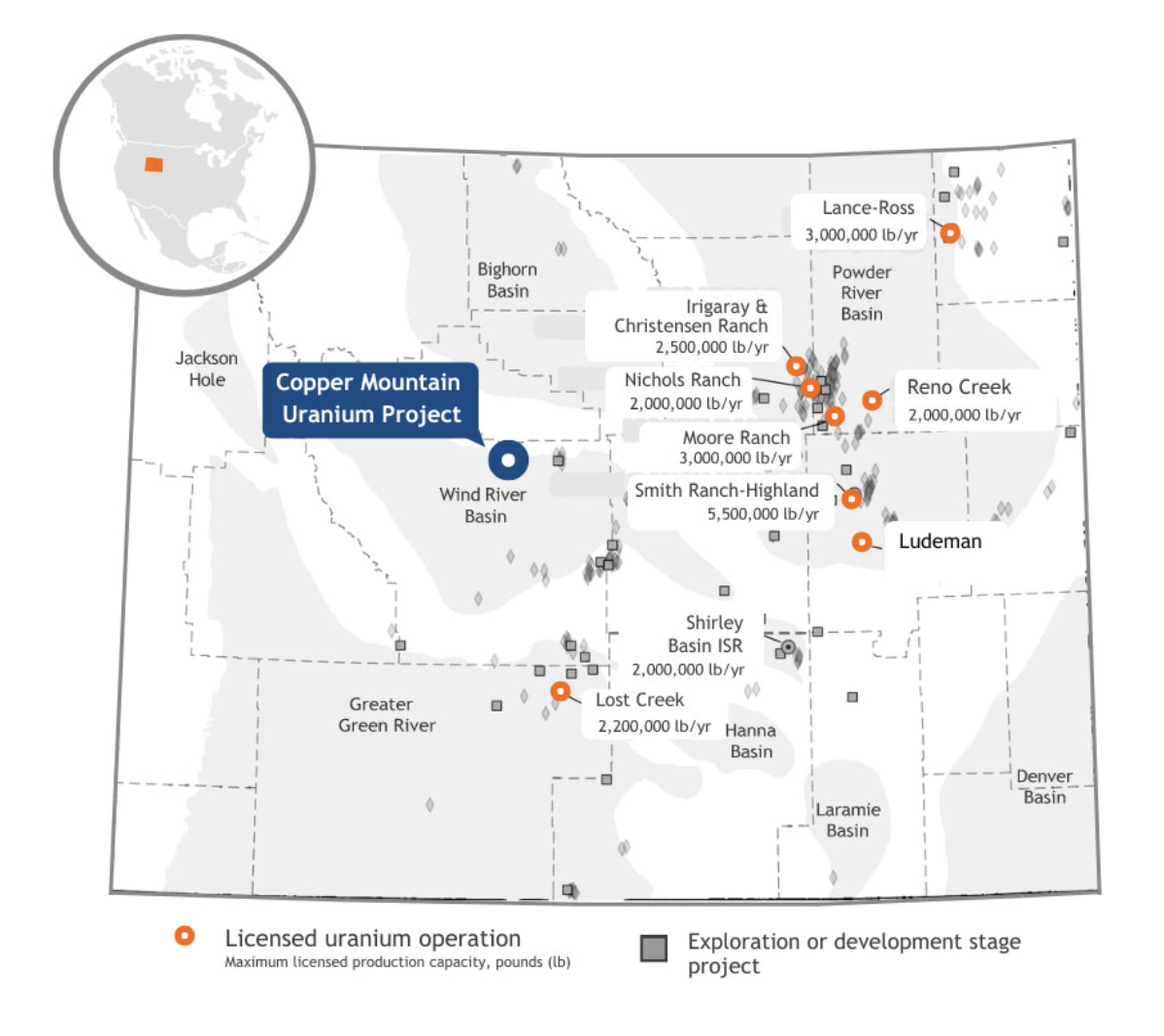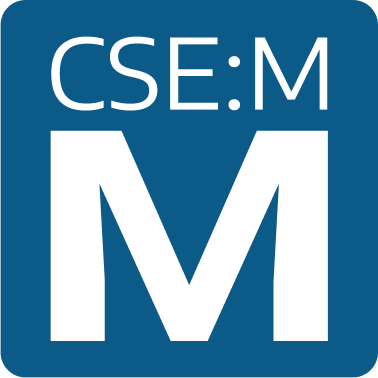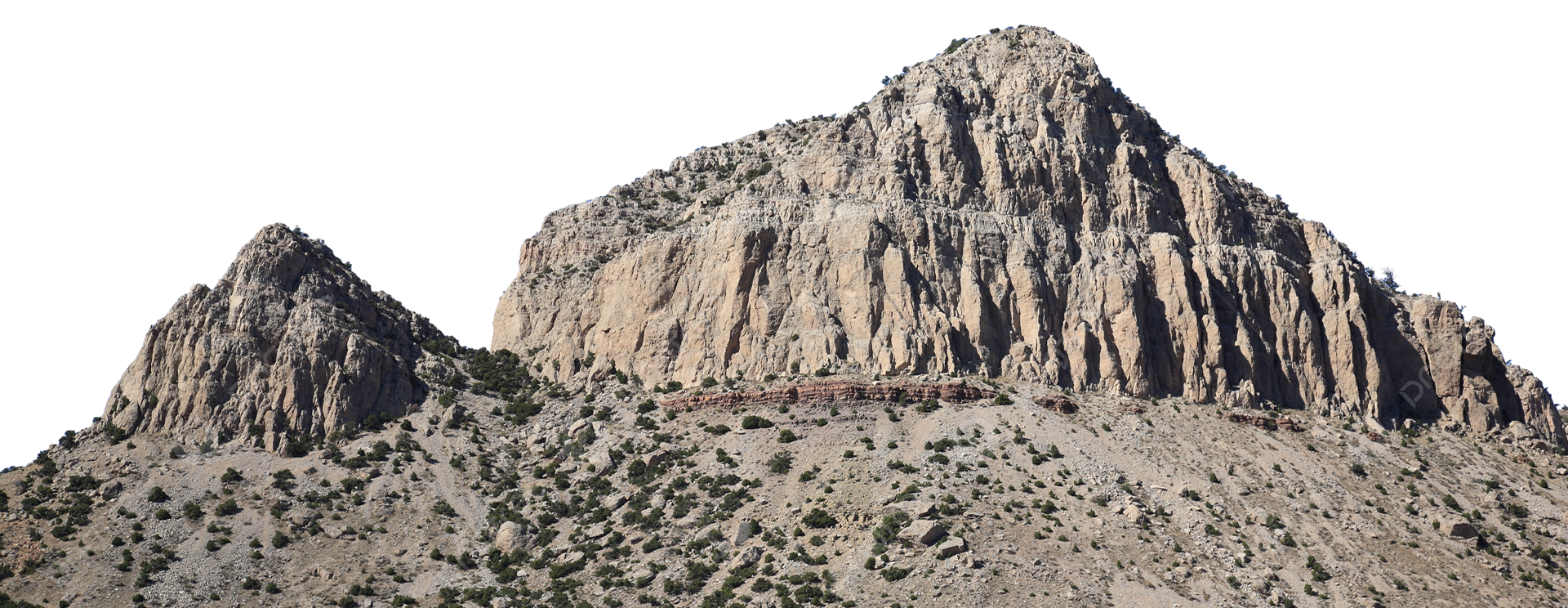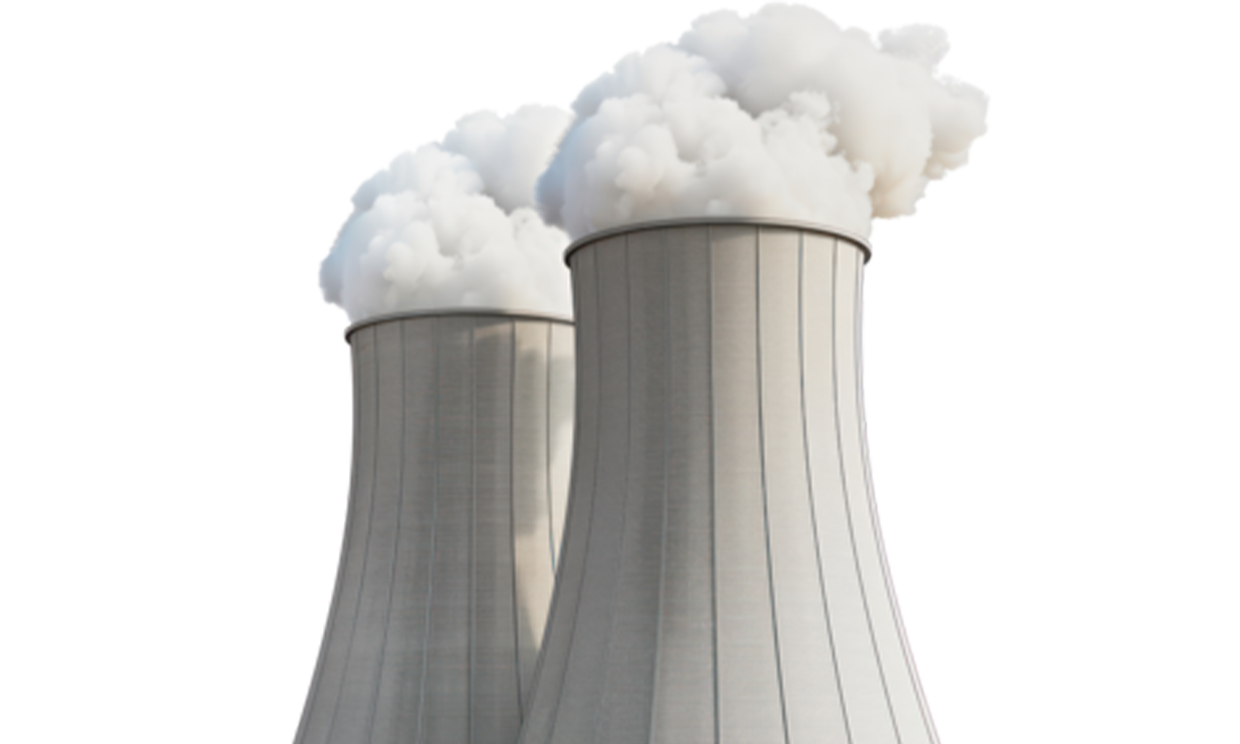


RECENT UPDATES: The Copper Mountain Uranium Project in Wyoming is Myriad Uranium’s primary asset and represents the focus of its exploration efforts. The Bendix Field Engineering Corporation assessment (1982) for the U.S. Department of Energy outlined the potential uranium oxide endowment in two key zones:These figures are historical and not NI 43-101-compliant, but are supported by extensive dataset including over 2,000 boreholes, geological and geophysical data from Union Pacific, and Bendix’s independent analysis.
Scale and Significance: The Bendix assessment indicates that the Copper Mountain district could host 655 million pounds of uranium oxide. This positions Copper Mountain as one of the largest undeveloped uranium districts in the U.S., potentially far exceeding earlier 1970s Union Pacific estimates.
Chemical assays returned 20–60% higher grades than gamma probe readings. One hole produced results 250% higher than gamma estimates. This suggests that the historical endowment is likely understated. New mineralization was also found well below the 600-foot “hard deck”, including at depths of 1,495 feet, pointing to deeper and possibly unconformity-related mineralization.
Strategic and Economic Implications:
A Rare Opportunity in America’s Nuclear FutureAs the world faces an escalating energy crisis and mounting geopolitical tensions, uranium is entering the spotlight as a critical commodity for global energy security. Nowhere is this more urgent than in the United States—where demand for nuclear power far outpaces domestic uranium production. Against this backdrop, Myriad Uranium has positioned itself as a standout opportunity for investors seeking early-stage exposure to North American uranium with world-class upside.
Uranium Disequilibrium: Chemical Assays have Confirmed that Uranium Grades are on Average Up to 60% Higher than Previously Thought.Myriad’s maiden drill program in late 2024 marked a turning point for the company. At the Canning Deposit—central to Union Pacific’s historic mine plan—drilling delivered 30 intercepts exceeding 1,000 ppm eU₃O₈ across just 34 holes. Subsequent chemical assays have revealed the true scale of that understatement. Where historical gamma probe readings registered estimated uranium grades of 1,000 ppm eU₃O₈ or more, chemical assays (the "gold standard" method) confirmed that actual uranium grades are in fact 60% higher on average, with 1,000 ppm eU₃O₈ intervals now boosted to 1,600 ppm U₃O₈, 2,000 ppm boosted to 3,200 ppm, and so on. This effect is the result of uranium disequilibrium—a geological phenomenon that causes an imbalance between uranium and its daughter products that can result in differences between radiometric equivalent uranium and actual uranium.
“When we ran the chemical assays, we found that where probes estimated grades of 1,000 ppm eU₃O₈ or higher—(0.1% estimated uranium or higher)—the grade jumped by 60%,” noted a company representative. “In other words, 1,000 ppm on average became 1,600 ppm and up.”
These confirmations of additional uranium are very exciting, because they mean that Copper Mountain, which was already slated to become a large-scale uranium mine, may have significantly more uranium than previously thought.
Not only do these assays confirm higher grades on average, but some intervals have returned significantly higher grades where low or even below cut-off grades were expected—effectively extending mineralized zones. This outcome suggests Copper Mountain may host significantly more uranium than previously thought, strengthening the case for aggressive follow-up drilling.
Read the news here: Major Breakthrough
ALSO: Myriad Uranium and Rush Rare Metals Announce Proposed MergerMyriad Uranium and Rush Rare Metals Corp. (CSE: RSH) have signed a letter of intent to merge, with Myriad acquiring all outstanding Rush shares through a statutory plan of arrangement. Under the proposed terms, Rush shareholders will receive one Myriad share for every two Rush shares held, and Rush’s convertible securities will convert to Myriad equivalents on the same ratio. Rush will also spin out its Boxi Property in Quebec into a new company, “Rush Spinco,” with shares distributed to Rush shareholders at closing.
The companies are already partners at the Copper Mountain Project in Wyoming, where Myriad has earned a 50% interest and is working toward 75% ownership through an additional $4 million in exploration. Both management teams believe 100% unified ownership will significantly enhance the project’s value, attract institutional and strategic investors, and position Copper Mountain as a major U.S. uranium district. Rush shareholders will benefit from a stake in Myriad and continued exposure to Boxi through Rush Spinco. The merger remains subject to due diligence, definitive agreements, shareholder and court approvals, and CSE acceptance.
A Critical Moment for American UraniumThe U.S. nuclear fleet is the largest in the world, consuming over 40 million pounds of uranium annually—yet producing less than 1% of that domestically. With geopolitical risk rising, particularly around Russian and Kazakh supply chains, Washington is aggressively shifting toward energy independence. Key legislation, including the Prohibiting Russian Uranium Imports Act (H.R.1042), is already redirecting billions toward domestic production and enrichment.
Wyoming—home to four of America’s five operating uranium mines—is ground zero for this resurgence. And at the heart of it sits Myriad’s Copper Mountain Project.
Copper Mountain: A District-Scale Asset with 100 Mlbs+ PotentialCopper Mountain is potentially one of the largest uranium projects in Wyoming, an area with rich history and infrastructure for uranium mining. Myriad has consolidated a 75% earnable interest in the entire district—bringing together 7 historic deposits, numerous past-producing mines, and vast exploration upside for the first time since Union Pacific’s ambitious plans in the 1970s.
Union Pacific and California Edison once planned to mine Copper Mountain to power California’s nuclear future, investing what today would be C$117 million. They drilled over 2,000 boreholes, outlined a six-pit mine plan, and estimated 65+ million pounds of uranium potential in the area of known deposits and prospects—and possibly much more across the district. However, the project was shelved after the Three Mile Island incident crushed uranium prices.
Fast forward to 2024, and Myriad has now verified—and exceeded—Union Pacific’s historical drilling results.
Myriad’s maiden drill program in late 2024 delivered a major breakthrough. Drilling at the Canning Deposit, the core of Union Pacific’s historical plan, returned 30 intercepts over 1,000 ppm eU3O8 across just 34 holes. One borehole, CAN0006, reached a peak grade of 8,060 ppm.
Importantly, Myriad drilled deeper than Union Pacific average “hard deck” of 500–600 feet and encountered mineralization at deeper levels (up to 1500 ft). These results suggest the Copper Mountain system may be far more extensive and high-grade than previously thought.
Insiders, including CEO Thomas Lamb, own 22% of the company’s shares. Additionally, Myriad is also backed by one of the top five global uranium trading houses, underscoring strong strategic interest.All of the estimates referred to above are historical and are not current under NI 43-101. The content of this website is derived from Myriad Uranium Corp. press releases which can be viewed here https://myriaduranium.com/news/. They include important information regarding historical estimates, including that the estimates referred to are decades old and are not being treated by Myriad as current mineral resource or mineral reserve. The technical and scientific information in the press releases from which the content of this website is derived were approved by a Qualified Person as defined in NI 43-101.
RECENT UPDATES: The Copper Mountain Uranium Project in Wyoming is Myriad Uranium’s primary asset and represents the focus of its exploration efforts. The Bendix Field Engineering Corporation assessment (1982) for the U.S. Department of Energy outlined the potential uranium oxide endowment in two key zones:These figures are historical and not NI 43-101-compliant, but are supported by extensive dataset including over 2,000 boreholes, geological and geophysical data from Union Pacific, and Bendix’s independent analysis.
Scale and Significance: The Bendix assessment indicates that the Copper Mountain district could host 655 million pounds of uranium oxide. This positions Copper Mountain as one of the largest undeveloped uranium districts in the U.S., potentially far exceeding earlier 1970s Union Pacific estimates.
Chemical assays returned 20–60% higher grades than gamma probe readings. One hole produced results 250% higher than gamma estimates. This suggests that the historical endowment is likely understated. New mineralization was also found well below the 600-foot “hard deck”, including at depths of 1,495 feet, pointing to deeper and possibly unconformity-related mineralization.
Strategic and Economic Implications:
A Rare Opportunity in America’s Nuclear FutureAs the world faces an escalating energy crisis and mounting geopolitical tensions, uranium is entering the spotlight as a critical commodity for global energy security. Nowhere is this more urgent than in the United States—where demand for nuclear power far outpaces domestic uranium production. Against this backdrop, Myriad Uranium has positioned itself as a standout opportunity for investors seeking early-stage exposure to North American uranium with world-class upside.
Uranium Disequilibrium: Chemical Assays have Confirmed that Uranium Grades are on Average Up to 60% Higher than Previously Thought.Myriad’s maiden drill program in late 2024 marked a turning point for the company. At the Canning Deposit—central to Union Pacific’s historic mine plan—drilling delivered 30 intercepts exceeding 1,000 ppm eU₃O₈ across just 34 holes. Subsequent chemical assays have revealed the true scale of that understatement. Where historical gamma probe readings registered estimated uranium grades of 1,000 ppm eU₃O₈ or more, chemical assays (the "gold standard" method) confirmed that actual uranium grades are in fact 60% higher on average, with 1,000 ppm eU₃O₈ intervals now boosted to 1,600 ppm U₃O₈, 2,000 ppm boosted to 3,200 ppm, and so on. This effect is the result of uranium disequilibrium—a geological phenomenon that causes an imbalance between uranium and its daughter products that can result in differences between radiometric equivalent uranium and actual uranium.
“When we ran the chemical assays, we found that where probes estimated grades of 1,000 ppm eU₃O₈ or higher—(0.1% estimated uranium or higher)—the grade jumped by 60%,” noted a company representative. “In other words, 1,000 ppm on average became 1,600 ppm and up.”
These confirmations of additional uranium are very exciting, because they mean that Copper Mountain, which was already slated to become a large-scale uranium mine, may have significantly more uranium than previously thought.
Not only do these assays confirm higher grades on average, but some intervals have returned significantly higher grades where low or even below cut-off grades were expected—effectively extending mineralized zones. This outcome suggests Copper Mountain may host significantly more uranium than previously thought, strengthening the case for aggressive follow-up drilling.
Read the news here: Major Breakthrough
ALSO: Myriad Uranium and Rush Rare Metals Announce Proposed MergerMyriad Uranium and Rush Rare Metals Corp. (CSE: RSH) have signed a letter of intent to merge, with Myriad acquiring all outstanding Rush shares through a statutory plan of arrangement. Under the proposed terms, Rush shareholders will receive one Myriad share for every two Rush shares held, and Rush’s convertible securities will convert to Myriad equivalents on the same ratio. Rush will also spin out its Boxi Property in Quebec into a new company, “Rush Spinco,” with shares distributed to Rush shareholders at closing.
The companies are already partners at the Copper Mountain Project in Wyoming, where Myriad has earned a 50% interest and is working toward 75% ownership through an additional $4 million in exploration. Both management teams believe 100% unified ownership will significantly enhance the project’s value, attract institutional and strategic investors, and position Copper Mountain as a major U.S. uranium district. Rush shareholders will benefit from a stake in Myriad and continued exposure to Boxi through Rush Spinco. The merger remains subject to due diligence, definitive agreements, shareholder and court approvals, and CSE acceptance.
A Critical Moment for American UraniumThe U.S. nuclear fleet is the largest in the world, consuming over 40 million pounds of uranium annually—yet producing less than 1% of that domestically. With geopolitical risk rising, particularly around Russian and Kazakh supply chains, Washington is aggressively shifting toward energy independence. Key legislation, including the Prohibiting Russian Uranium Imports Act (H.R.1042), is already redirecting billions toward domestic production and enrichment.
Wyoming—home to four of America’s five operating uranium mines—is ground zero for this resurgence. And at the heart of it sits Myriad’s Copper Mountain Project.
Copper Mountain: A District-Scale Asset with 100 Mlbs+ PotentialCopper Mountain is potentially one of the largest uranium projects in Wyoming, an area with rich history and infrastructure for uranium mining. Myriad has consolidated a 75% earnable interest in the entire district—bringing together 7 historic deposits, numerous past-producing mines, and vast exploration upside for the first time since Union Pacific’s ambitious plans in the 1970s.
Union Pacific and California Edison once planned to mine Copper Mountain to power California’s nuclear future, investing what today would be C$117 million. They drilled over 2,000 boreholes, outlined a six-pit mine plan, and estimated 65+ million pounds of uranium potential in the area of known deposits and prospects—and possibly much more across the district. However, the project was shelved after the Three Mile Island incident crushed uranium prices.
Fast forward to 2024, and Myriad has now verified—and exceeded—Union Pacific’s historical drilling results.
Myriad’s maiden drill program in late 2024 delivered a major breakthrough. Drilling at the Canning Deposit, the core of Union Pacific’s historical plan, returned 30 intercepts over 1,000 ppm eU3O8 across just 34 holes. One borehole, CAN0006, reached a peak grade of 8,060 ppm.
Importantly, Myriad drilled deeper than Union Pacific average “hard deck” of 500–600 feet and encountered mineralization at deeper levels (up to 1500 ft). These results suggest the Copper Mountain system may be far more extensive and high-grade than previously thought.
Insiders, including CEO Thomas Lamb, own 22% of the company’s shares. Additionally, Myriad is also backed by one of the top five global uranium trading houses, underscoring strong strategic interest.All of the estimates referred to above are historical and are not current under NI 43-101. The content of this website is derived from Myriad Uranium Corp. press releases which can be viewed here https://myriaduranium.com/news/. They include important information regarding historical estimates, including that the estimates referred to are decades old and are not being treated by Myriad as current mineral resource or mineral reserve. The technical and scientific information in the press releases from which the content of this website is derived were approved by a Qualified Person as defined in NI 43-101.
https://myriaduranium.com/
https://www.cruxinvestor.com/posts/myriad-uranium-receives-federal-approval-for-222-borehole-exploration-programme-at-copper-mountain


The recent global push for nuclear energy is being driven by the urgent need to decarbonize, strengthen energy security, and embrace next-generation technologies. As countries aim for net-zero emissions, nuclear power offers a reliable, low-carbon alternative to fossil fuels and a complement to intermittent renewables like wind and solar. Global Uranium Crisis = Major U.S. OpportunityInnovations such as Small Modular Reactors (SMRs) are making nuclear more scalable, affordable, and flexible, while increased government incentives—like those in the U.S., Canada, and the EU—are unlocking new funding. At the same time, public perception is shifting, particularly among younger, climate-focused demographics, who increasingly view nuclear as a necessary part of a sustainable energy future.Undervalued: Share price US$0.19 vs. US$1.35 price target (Singular Research)Major catalysts ahead: NI 43-101 resource (Q1 2025), drill expansion, investor campaignInsiders own 22% + backed by one of the top 5 global uranium trading housesLocated in Wyoming – the #1 U.S. uranium jurisdictionConclusion: Positioned to Lead the American Uranium RevivalFor investors seeking leverage to the next phase of the nuclear energy boom, Myriad offers rare ground-floor exposure with room to run.
All of the estimates referred to above are historical and are not current under NI 43-101. The content of this website is derived from Myriad Uranium Corp. press releases which can be viewed here https://myriaduranium.com/news/. They include important information regarding historical estimates, including that the estimates referred to are decades old and are not being treated by Myriad as current mineral resource or mineral reserve. The technical and scientific information in the press releases from which the content of this website is derived were approved by a Qualified Person as defined in NI 43-101.
Notes to Historic Resources Disclosure:
The following sources are relevant to the historic resource or grade estimates referred to in this document:
The historic resources referred to here were estimated on the basis of over 900,000 feet of hammer tool and core drilling. The data collection methods applied at the time are considered appropriate and reliable and the estimates derived from them are considered relevant.
The resultant gamma logs and core assays that supported metallurgical test results, process design studies, reserve calculations, engineering and feasibility studies, and environmental studies and baseline permitting data were not available to the QP, therefore a complete and thorough review of the data has not been possible.
Rocky Mountain Energy Corp. used the polygonal estimation method based on ten-foot composite thicknesses and 0.010% U308 cut off using gamma probe grades with a tonnage factor 12 cubic ft/ton.
These estimates are not current under NI 43-101. The “most likely mineable reserves” estimated by RMEC as presented in the reports would be categorized as Indicated and Inferred resources, in accordance with the CIM Definition Standards for Mineral Resources & Mineral Reserves (2014).
The portions of the “reserves” (approximately 20 to 60%) that were drilled on a 15 to 30 metre (50 to 100 foot) centers, and normally would be classified as Measured resources, are equated to Indicated resources, because of the nature of the mineralization, uncertainty regarding the grades and the lack of established economic viability of the deposits at the time. The remaining portions of the “reserves” drilled on 30 to 60 metre (100 to 200 foot) centers, are classified as Inferred resources. An attempt to separate the indicated from the inferred resources was not possible from the available information.
A qualified person has not done sufficient work to classify the historical estimate as current mineral resources or mineral reserves; and the issuer is not treating the historical estimate as current mineral resources or mineral reserves. In order to verify the historical resources and potentially re-state them as current resources, a program of digitization of data is required (to the extent possible), followed by re-logging and/or re-drilling to generate new data that is comparable with the original data that can be used to establish the correlation and continuity of geology and grades between boreholes with sufficient confidence to estimate mineral resources.
The recent global push for nuclear energy is being driven by the urgent need to decarbonize, strengthen energy security, and embrace next-generation technologies. As countries aim for net-zero emissions, nuclear power offers a reliable, low-carbon alternative to fossil fuels and a complement to intermittent renewables like wind and solar. Global Uranium Crisis = Major U.S. OpportunityInnovations such as Small Modular Reactors (SMRs) are making nuclear more scalable, affordable, and flexible, while increased government incentives—like those in the U.S., Canada, and the EU—are unlocking new funding. At the same time, public perception is shifting, particularly among younger, climate-focused demographics, who increasingly view nuclear as a necessary part of a sustainable energy future.Undervalued: Share price US$0.19 vs. US$1.35 price target (Singular Research)Major catalysts ahead: NI 43-101 resource (Q1 2025), drill expansion, investor campaignInsiders own 22% + backed by one of the top 5 global uranium trading housesLocated in Wyoming – the #1 U.S. uranium jurisdictionConclusion: Positioned to Lead the American Uranium RevivalFor investors seeking leverage to the next phase of the nuclear energy boom, Myriad offers rare ground-floor exposure with room to run.
All of the estimates referred to above are historical and are not current under NI 43-101. The content of this website is derived from Myriad Uranium Corp. press releases which can be viewed here https://myriaduranium.com/news/. They include important information regarding historical estimates, including that the estimates referred to are decades old and are not being treated by Myriad as current mineral resource or mineral reserve. The technical and scientific information in the press releases from which the content of this website is derived were approved by a Qualified Person as defined in NI 43-101.
Notes to Historic Resources Disclosure:
The following sources are relevant to the historic resource or grade estimates referred to in this document:
The historic resources referred to here were estimated on the basis of over 900,000 feet of hammer tool and core drilling. The data collection methods applied at the time are considered appropriate and reliable and the estimates derived from them are considered relevant.
The resultant gamma logs and core assays that supported metallurgical test results, process design studies, reserve calculations, engineering and feasibility studies, and environmental studies and baseline permitting data were not available to the QP, therefore a complete and thorough review of the data has not been possible.
Rocky Mountain Energy Corp. used the polygonal estimation method based on ten-foot composite thicknesses and 0.010% U308 cut off using gamma probe grades with a tonnage factor 12 cubic ft/ton.
These estimates are not current under NI 43-101. The “most likely mineable reserves” estimated by RMEC as presented in the reports would be categorized as Indicated and Inferred resources, in accordance with the CIM Definition Standards for Mineral Resources & Mineral Reserves (2014).
The portions of the “reserves” (approximately 20 to 60%) that were drilled on a 15 to 30 metre (50 to 100 foot) centers, and normally would be classified as Measured resources, are equated to Indicated resources, because of the nature of the mineralization, uncertainty regarding the grades and the lack of established economic viability of the deposits at the time. The remaining portions of the “reserves” drilled on 30 to 60 metre (100 to 200 foot) centers, are classified as Inferred resources. An attempt to separate the indicated from the inferred resources was not possible from the available information.
A qualified person has not done sufficient work to classify the historical estimate as current mineral resources or mineral reserves; and the issuer is not treating the historical estimate as current mineral resources or mineral reserves. In order to verify the historical resources and potentially re-state them as current resources, a program of digitization of data is required (to the extent possible), followed by re-logging and/or re-drilling to generate new data that is comparable with the original data that can be used to establish the correlation and continuity of geology and grades between boreholes with sufficient confidence to estimate mineral resources.
https://myriaduranium.com/
https://www.cruxinvestor.com/posts/myriad-uranium-receives-federal-approval-for-222-borehole-exploration-programme-at-copper-mountain



